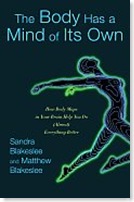Body Maps
From The Body Has a Mind of Its Own: How Body Maps in Your Brain Help You Do (Almost) Everything Better, by Sandra Blakeslee and Matthew Blakeslee:
Just as a road atlas is full of maps that represent real-world locations, your brain is full of maps that represent all aspects of your physical self, inside and out. Your brain is teeming with maps that underlie your ability to touch things, move about, act freely, feel emotion, and interact with others. But unlike road maps, your body maps are dynamic: They grow, shrink, and morph to suit your needs.
Each of your body parts is faithfully mapped based on the touch receptors embedded throughout your skin. This is your primary touch map. You also have a primary motor map, for making movements. Instead of receiving information from your skin, this map sends signals from your brain out to your muscles. Together, these two primary maps are the foundation of your mind-body interface.
 Elsewhere in your brain you have maps of the space around your body, out to the end of your fingertips. These personal space maps can extend even further, morphing like an amoeba's pseudopod to include any physical tool you pick up, any item of clothing or sporting equipment you put on, or even any virtual extension of yourself that you control with a mouse or a joystick, into your own bodily self-representation.
Elsewhere in your brain you have maps of the space around your body, out to the end of your fingertips. These personal space maps can extend even further, morphing like an amoeba's pseudopod to include any physical tool you pick up, any item of clothing or sporting equipment you put on, or even any virtual extension of yourself that you control with a mouse or a joystick, into your own bodily self-representation.
Some of your most amazing body maps are made up of special brain cells called mirror neurons. These cells fire when you observe someone doing an action—say, scratching their chin—and when you scratch your own chin. As a result, you may feel a desire to scratch your chin, or even develop a genuine itch there. Mirror neurons map the actions, intentions and emotions of others directly into your own system of body maps, creating as close to a telepathic link as the known laws of nature allow. They allow you to understand and empathize with the minds of others, not through conceptual reasoning, but through direct simulation via your own body maps. They reveal how children learn, why you respond to certain types of sports, dance, music and art, why media and video game violence can be harmful, the appeal of pornography, and may even help explain homophobia.
Your brain also has a set of maps of your internal organs. Present in all mammals, these visceral maps are uniquely super- developed in the human brain. Evolution has extended these maps' functions far beyond their original purpose of just letting you know you are hungry, thirsty, horny, or need air. These maps afford you a level of access to the ebb and flow of your internal sensations unrivaled anywhere else in the animal kingdom, and they are fundamental to the uniquely rich emotional inner life of our species. They are important in empathy, moral judgment, social intercourse, and many aspects of mental and physical health.
All these body maps are profoundly plastic—capable of significant reorganization in response to damage, experience or practice. Concert pianists have enlarged hand maps. Veteran meditators have enlarged visceral maps. Golfers with the yips and musicians with musician's cramp have blurred body maps. Autistic people have scrambled body maps.
...It comes down to the body maps in your brain. As science would have it, the mind is what the brain does. And the brain is intimately connected to the body, as studies of its sprawling network of body maps are revealing in ever greater detail. All your emotions, feelings, and your sense of individual selfhood stem from the interaction of these maps in your brain, the body in your brain, your embodied brain.





